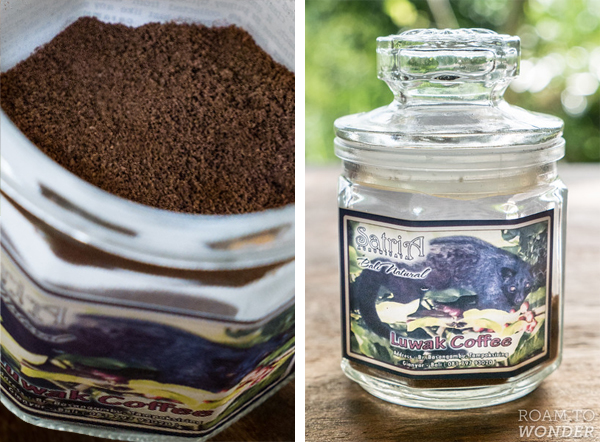Would You Drink Cat Poo Coffee or Kopi Luwak, a Local Coffee Delicacy in Bali?
Balinese are crazy about coffee, especially Kopi Luwak or what I call, cat-poo-cino, a local and highly sought after delicacy made from Arabica coffee beans produced from cat poo! Kopi means coffee in Indonesian and Luwak is a local name of the Asian Palm Civet, a cat-like creature originally from Sumatra.

A golden civet or luwak enjoying some bananas at the Uluwatu Temple market
What is Kopi Luwak?
The civets select the best coffee cherries to consume, in this case, Arabica coffee beans mostly for the fruity fleshy pulp. Their digestive mechanisms are stated to improve the flavor profile for the coffee beans because they ferment these partially digested coffee beans. These coffee beans are later excreted and collected by farmers and processed by washing, roasting, and finely grinding to prepare kopi luwak. Kopi luwak is known more for the novelty of the process than for its taste and it is called “one of the most expensive coffees in the world with retail prices reaching US $700 per kilogram” or around $80 for a cup. Kopi Luwak is currently the second most expensive coffee since the most expensive coffee is the Black Ivory Coffee, a local Northern Thailand delicacy made from poop by elephants consuming the same type of Arabica coffee beans. These can be fetched for “US $1,100 per kilogram” and only sold in luxury hotels and cafes.
Kopi luwak is produced mainly on the islands of Sumatra, Java, Bali and Sulawesi in Indonesia. It is also produced in the islands of the Philippines, East Timor, and Vietnam, but all have different names and prices associated with it. There has been some debate on the ethical methods on how kopi luwak is produced. PETA and other animal rights activists claim the production of kopi luwak is unethical because farmers would lock up civets in battery cages and would force-feed them. Caging civets prohibits them from roaming wild to enjoy their natural habitat and by having limited mobility, they ultimately become stressed, which reduce the quality of the coffee beans.
Here’s a little snippet from the movie “The Bucket List” about what kopi luwak is all about.
How Kopi Luwak is Produced
Step 1. Civets consume the cherry beans. It takes 24 hours to fully digest in their stomachs before they are excreted along with other byproducts like seeds, nuts, and coffee beans.

Civets are nocturnal creatures that feast on coffee cherries and defecate the coffee beans which create kopi luwak.

Coffee cherries the civet consumes, but cannot fully digest.
Step 2. Feces from civets are collected, dried, then separated to individual beans and washed. A considerable amount of weight is reduced here as nuts, seeds, and bad beans are separated out.

The excreted feces with coffee beans that cannot be digested by the civet

Top left, luwak poop in a clump, bottom separated into individual coffee beans. Middle right, vanilla beans.
Step 3. Once the coffee beans have been washed, they are left to dry in the sun for a few days so the papery parchment around the coffee been can be easily removed. It is washed and dried again.

The outer parchment is removed from the coffee beans shown here.
Step 4. The coffee beans are then roasted over the fire on a cast iron wok for an hour or more, constantly stirring to get a deep dark color and to extract strong bitter flavors. The coffee beans reduce in size through this process.

Woman roasting the coffee beans.
Step 5. Once the coffee beans are done roasting, they are placed in a pestle and mortar and are grounded up coarsely. It is then sifted out for impurities and grounded more finely.

Different phases the luwak coffee has been processed. In the far back, the coffee is roasted, on the right, the coffee is coarsely grounded, and bottom, coffee is finely grounded.
Step 6. The final product yields a finely grounded kopi luwak and packaged in a container for sale. One is by Satria Agrowisata, where we did our free coffee and tea tasting (details below) at and the other from a small shop at the Uluwatu Temple marketplace.

Finely ground kopi luwak in the Satria Agrowisata packaging.

Bali Civet Coffee sold at the market at Uluwatu Temple
Tasting Special Teas and Coffees of Bali
Our driver, Rama spent an entire day with us showing us some sites in the Ubud region of Bali and he surprised us with a stop at Satria Agrowisata, a tea and coffee plantation for a free tour of the premises including looking at the flora produced on-site (lemongrass, cocoa, cloves, cinnamon, coffee beans, and so many other plants used to produce the tea and coffee sold here). We also got a quick tour of the traditional kopi luwak roasting process and enjoyed a free coffee and tea tasting before being led to the shop where we purchased a few of our favorite teas to consume during our trip and to send some unique ones home for our family to try.
The free tasting included Ginseng Coffee, Coconut Coffee, Moccacino Coffee, Vanilla Coffee, Hot Cocoa, Saffron Tea, Mangosteen Tea, Bali Coffee, Lemon Grass Tea (Organic), Rose Tea (Organic), Ginger Tea, and Roselle Tea (Organic). We were led down some steep stairs to a shaded seating area under a hut overlooking the beautiful valley and plantation and enjoyed tasting everything here. Our guide informed us that some of these herbal teas had medicinal healing properties. Saffron for overall health, immunity and to aid digestion, Roselle (or hibiscus) to lower blood pressure, promote weight-loss, cure coughs, and Mangosteen for its anti-cancer properties, to lower blood pressure and cholesterol, and to reduce inflammation. There’s no pressure to purchase anything, so if you want to just enjoy the plantation and sample the tea/coffees, that would be fine.


After sampling the 12 different coffee and teas with Mangosteen, Roselle, and Saffron being our favorites tastewise and for their healing properties, I asked about the kopi luwak tasting. The kopi luwak tasting costed extra. Fortunately, it didn’t cost $80 a cup, but at 50,000 IDR or around $3.50 USD for a small cup.
Joshua outright opted out of drinking cat poo coffee or any kind of coffee because he doesn’t like the bitter taste of coffee. And since I have a knack to try new and unique things, I, of course, tried it. I’ve been wanting to try it since we first saw the civets napping at the market at Uluwatu Temple but was a little apprehensive about drinking it and getting food poisoning from the deadly E. Coli bacteria from something that is predominately made from poop. After watching how kopi luwak was produced, I felt reassured I would not get food poisoning. I paid for the cup, with coffee in hand, Joshua intently stared at me with a grossed out look on his face as I took a sip of kopi luwak, black. I felt an immediate jolt of adrenaline rush throughout my body and my taste buds were hit with a strong, sharp bitterness and grittiness from the coffee and grinds. I promptly added cream and sugar to make it less bitter so I could finish the cup of kopi luwak. Coffee connoisseurs say kopi luwak is mostly consumed for novelty since there is no distinguishable taste, one even said it tasted like Folgers.
Would You Drink Cat Poo Coffee
So kopi luwak is safe to drink, but the question is, would you want to try it for the taste or for the novelty? And the next thought is, can you get over the fact it came from the bowels of a cat? I knew I gave into the gimmick and tried it mostly for the novelty and so I can say I drank the second most expensive cup of coffee in the world and it’s made from cat poop!
